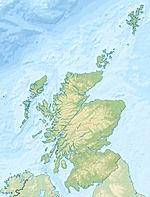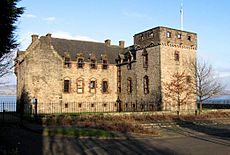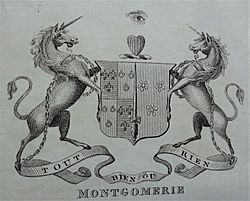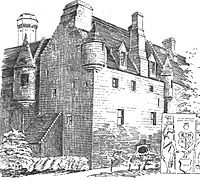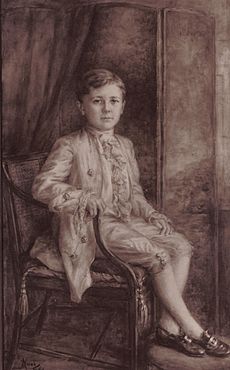Skelmorlie Castle facts for kids
Quick facts for kids Skelmorlie Castle |
|
|---|---|
| Skelmorlie, North Ayrshire, Scotland UK |
|

Skelmorlie Castle in 1829
|
|
| Coordinates | 55°51′07″N 4°53′05″W / 55.8520°N 4.8847°W |
| Grid reference | NS 19524 65838 |
| Type | Scottish Tower House |
| Site information | |
| Open to the public |
No |
| Condition | in excellent repair |
| Site history | |
| Built | end 15th/early 16th century |
| Built by | George Montgomerie, First of Skelmorlie |
| In use | Private dwelling in routine use |
| Materials | Red Sandstone block & rubble |
Skelmorlie Castle is an old castle located on the eastern shore of the Firth of Clyde in Scotland. It stands in the north-western part of Ayrshire. The castle was built in 1502. It used to be the main home and strong fort for the Montgomery family. The modern village of Skelmorlie is just north of the castle.
Contents
Castle History
The name 'Skelmorlie' has changed over time on old maps. It might mean 'shelter on the calm side of a big rock'. The 'Skel-' part could be like 'Skeir' or 'Skerries', which refer to rocky islands.
Early Owners: The Cunninghame Family
Around the late 1300s and early 1400s, the Cunninghame family owned the lands of Skelmorlie. Then, around 1460, the northern part of the land went to the Montgomerie family. The rest stayed with the Cunninghames. This split might have happened because a Montgomerie married a Cunninghame.
The Montgomerie Family at Skelmorlie
The Castle Builders
On June 6, 1461, Sir Alexander de Montgomerie gave the lands of Skelmorlie to his second son, George. George became the first of the Montgomeries of Skelmorlie. He also received other lands nearby. Some people believe Skelmorlie Castle was built by a brother of Hugh, who was the first Earl of Eglinton.
The Montgomerie family continued to live at Skelmorlie. Many generations of Montgomerie men became the lairds (lords) of the castle.
Famous Montgomerie Lairds
Sir Robert Montgomerie, the seventh laird, was made a knight by King James VI. Later, King Charles I made him a baronet in 1628. A baronet is a special title, like a knight, that can be passed down in the family.
Sir Robert, the first baronet, was known for his bravery. He even became friends with Patrick Maxwell, whose family had been in a feud with the Montgomeries. Sir Robert married Margaret Douglas, who was very beautiful and famous in songs of the time.
Another Sir Robert, the third baronet, had a wife named Antonia. She was a strong supporter of the Covenanters, a religious group. Her husband was often fined because she attended their meetings.
Sir James, the fourth baronet, was involved in politics. He was part of the Parliament that offered the crown to King William and Queen Mary. Later, he supported the old King James II. Sir James died in London in 1694.
The Skelmorlie estate was later bought by Hugh Montgomerie of Busbie. He became the sixth baronet. Hugh helped negotiate the union between Scotland and England. He died in 1735 without children, and so the baronet title ended.
The Skelmorlie estate then went to Lilias, the daughter of the fourth baronet. Her son, Hugh, became the 12th Earl of Eglinton. Lilias sold some of her lands and bought more land near Skelmorlie.
Family Symbols: Heraldry
The Montgomerie of Skelmorlie family had a special coat of arms. It combined symbols from the Montgomerie family and the Eglinton family. The Montgomerie part had three gold fleur-de-lis (flower symbols) on a blue background. The Eglinton part had three gold rings with gemstones on a red background. In the middle, there was a white sword pointing down.
Their crest was a heart with an eye above it. Their motto was Tout bien ou rein, which means "everything well (done) or nothing (attempted)".
The Skelmorlie Aisle

Near the castle, in Largs, there is a beautiful tomb called the Skelmorlie Aisle. Sir Robert Montgomerie built it as a resting place for his wife, Margaret Douglas. She died in a riding accident after falling from her horse. People used to say her ghost haunted Skelmorlie Castle. However, the ghost supposedly left after a fire in 1959. Sir Robert is also buried there in a lead coffin.
Sir Robert was known for being very charitable and religious after his wife's death. He spent many nights praying in the tomb. His coffin has a strange message in Latin, which means: "I was dead before myself; I expected my own funeral; alone, of all mortals, following the example of Caesar." This refers to an old Roman emperor who had his funeral before he died. It might mean Sir Robert spent so much time in the tomb praying that it felt like he was already dead.
There's a story that a local warlock (a male witch) once tried to bring the Devil to harm Sir Robert. But Sir Robert was deep in prayer, and the Devil couldn't do anything evil.
You can see a picture of Skelmorlie Castle in one of the painted panels on the ceiling of the Skelmorlie Aisle.
The Castle and Its Grounds
The oldest part of Skelmorlie Castle was built in 1502. More parts were added in 1636. The castle is described as a "fair well built house" with "old-fashioned gardens, terrace and shrubbery." It has amazing views over the Firth of Clyde to the islands of Bute, Arran, and Cumbrae.
The main hall was on the first floor. It used to have the Montgomerie coat of arms on the roof. The castle chapel, which later became stables, is still there.
Skelmorlie Castle's tower is similar in size and layout to other towers in the area, like those at Little Cumbrae, Fairlie, and Law.
In the early 1800s, the castle grounds were described as "beautifully laid out" with "rich and luxuriant woods." The only downside was that it was hard to get to because it was on a steep hill. An old map from 1855 shows a bowling green and a sundial. The old mill, called 'Milnburn', is also near the Skelmorlie Water.
The castle's shape has stayed mostly the same for over 500 years. It is made of red sandstone. In the early 1960s, after a fire in 1959, the castle was repaired. The fire damaged the upper floors of the main tower and a side wing. The wing was taken down, and the tower was fixed up.
Historic Scotland listed Skelmorlie Castle and its other old buildings as "Category B" in 1971. This means they are important historical buildings.
Who Lived Here Since the 1800s?
Major-General James Montgomerie lived at the castle for a long time in the early 1800s. He was the brother of the 12th Earl of Eglinton. During his time, the castle remained old but a bit run down.
From 1852 to 1890, John Graham, a merchant from Glasgow, rented the castle. He loved art and had a great collection. He rebuilt the castle in 1856, fixing the old tower and adding a new part that connected two old buildings.
The 16th Earl of Eglinton moved to Skelmorlie Castle in the mid-1920s. This was after the family's other home, Eglinton Castle, was no longer used. The 16th Earl died at Skelmorlie Castle in 1945. The castle was later sold by the 18th Earl of Eglinton.
The Wilson family owned the castle from the mid-1970s. They also owned a meat canning factory. In 2007, the castle was put up for sale again. New private owners bought it in the summer of 2009.
Archaeological Finds
Experts have found interesting things around Skelmorlie. A stone axe, about 6 inches long, was found in a field nearby. It is now kept in the Hunterian Museum in Glasgow. There was also a place called a 'Judge's Mound', which might have been an old meeting place or court.
The Serpent Mound
Near the castle, at Meigle, there is a large mound of earth about 100 feet high. Some people believed it was used for sun and serpent worship long ago. A doctor named Phenè explored it and found a paved area shaped like a circle, along with bones and charcoal. The mound itself might be natural, but the paved platform is definitely man-made.
|


